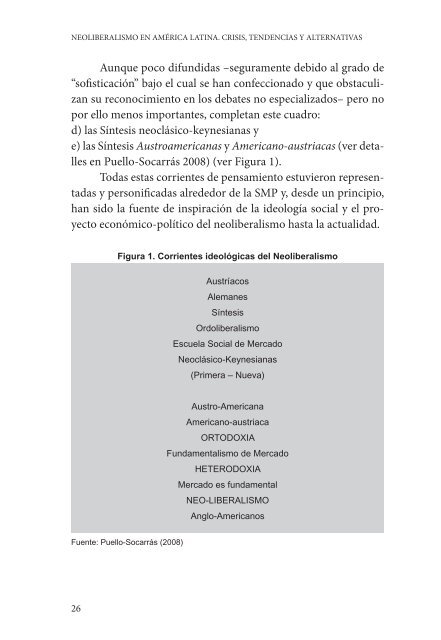- Page 2 and 3: NEOLIBERALISMO EN AMÉRICA LATINA.
- Page 4 and 5: NEOLIBERALISMO EN AMÉRICA LATINA.
- Page 6 and 7: Colección Grupos de Trabajo NEOLIB
- Page 8 and 9: Índice Luis Rojas Villagra PRESENT
- Page 10 and 11: Luis Rojas Villagra PRESENTACIÓN E
- Page 12 and 13: Presentación beralismo recargado i
- Page 14 and 15: Presentación además de varios enf
- Page 16 and 17: José Francisco Puello-Socarrás *
- Page 18 and 19: José Francisco Puello-Socarrás At
- Page 20 and 21: José Francisco Puello-Socarrás Pr
- Page 24 and 25: José Francisco Puello-Socarrás No
- Page 26 and 27: José Francisco Puello-Socarrás le
- Page 28 and 29: José Francisco Puello-Socarrás li
- Page 30 and 31: José Francisco Puello-Socarrás Ba
- Page 32 and 33: José Francisco Puello-Socarrás ch
- Page 34 and 35: José Francisco Puello-Socarrás ta
- Page 36 and 37: José Francisco Puello-Socarrás BI
- Page 38 and 39: José Francisco Puello-Socarrás Pu
- Page 40 and 41: Antonio Elías * LA OFENSIVA DEL CA
- Page 42 and 43: Antonio Elías La ofensiva del capi
- Page 44 and 45: Antonio Elías 1991:43). Lo anterio
- Page 46 and 47: Antonio Elías en los procesos de i
- Page 48 and 49: Antonio Elías En este marco se ins
- Page 50 and 51: Antonio Elías cooperación; el com
- Page 52 and 53: Antonio Elías compra de bienes y m
- Page 54 and 55: Antonio Elías tipo; b) Trato nacio
- Page 56 and 57: Antonio Elías da enmendar detalles
- Page 58 and 59: Antonio Elías Una característica
- Page 60 and 61: Antonio Elías Elías, Antonio 2012
- Page 62 and 63: NEOLIBERALISMO EN AMÉRICA LATINA.
- Page 64 and 65: NEOLIBERALISMO EN AMÉRICA LATINA.
- Page 66 and 67: NEOLIBERALISMO EN AMÉRICA LATINA.
- Page 68 and 69: NEOLIBERALISMO EN AMÉRICA LATINA.
- Page 70 and 71: NEOLIBERALISMO EN AMÉRICA LATINA.
- Page 72 and 73:
NEOLIBERALISMO EN AMÉRICA LATINA.
- Page 74 and 75:
NEOLIBERALISMO EN AMÉRICA LATINA.
- Page 76 and 77:
NEOLIBERALISMO EN AMÉRICA LATINA.
- Page 78 and 79:
SECCIÓN 2 EL NEOLIBERALISMO Y SUS
- Page 80 and 81:
NEOLIBERALISMO EN AMÉRICA LATINA.
- Page 82 and 83:
NEOLIBERALISMO EN AMÉRICA LATINA.
- Page 84 and 85:
NEOLIBERALISMO EN AMÉRICA LATINA.
- Page 86 and 87:
NEOLIBERALISMO EN AMÉRICA LATINA.
- Page 88 and 89:
NEOLIBERALISMO EN AMÉRICA LATINA.
- Page 90 and 91:
NEOLIBERALISMO EN AMÉRICA LATINA.
- Page 92 and 93:
NEOLIBERALISMO EN AMÉRICA LATINA.
- Page 94 and 95:
NEOLIBERALISMO EN AMÉRICA LATINA.
- Page 96 and 97:
NEOLIBERALISMO EN AMÉRICA LATINA.
- Page 98 and 99:
NEOLIBERALISMO EN AMÉRICA LATINA.
- Page 100 and 101:
NEOLIBERALISMO EN AMÉRICA LATINA.
- Page 102 and 103:
NEOLIBERALISMO EN AMÉRICA LATINA.
- Page 104 and 105:
NEOLIBERALISMO EN AMÉRICA LATINA.
- Page 106 and 107:
NEOLIBERALISMO EN AMÉRICA LATINA.
- Page 108 and 109:
NEOLIBERALISMO EN AMÉRICA LATINA.
- Page 110 and 111:
NEOLIBERALISMO EN AMÉRICA LATINA.
- Page 112 and 113:
NEOLIBERALISMO EN AMÉRICA LATINA.
- Page 114 and 115:
NEOLIBERALISMO EN AMÉRICA LATINA.
- Page 116 and 117:
NEOLIBERALISMO EN AMÉRICA LATINA.
- Page 118 and 119:
NEOLIBERALISMO EN AMÉRICA LATINA.
- Page 120 and 121:
NEOLIBERALISMO EN AMÉRICA LATINA.
- Page 122 and 123:
NEOLIBERALISMO EN AMÉRICA LATINA.
- Page 124 and 125:
NEOLIBERALISMO EN AMÉRICA LATINA.
- Page 126 and 127:
NEOLIBERALISMO EN AMÉRICA LATINA.
- Page 128 and 129:
NEOLIBERALISMO EN AMÉRICA LATINA.
- Page 130 and 131:
NEOLIBERALISMO EN AMÉRICA LATINA.
- Page 132 and 133:
NEOLIBERALISMO EN AMÉRICA LATINA.
- Page 134 and 135:
NEOLIBERALISMO EN AMÉRICA LATINA.
- Page 136 and 137:
NEOLIBERALISMO EN AMÉRICA LATINA.
- Page 138 and 139:
NEOLIBERALISMO EN AMÉRICA LATINA.
- Page 140 and 141:
Carolina Jiménez Martín * CRISIS
- Page 142 and 143:
Carolina Jiménez Martín nido en l
- Page 144 and 145:
Carolina Jiménez Martín TENSIONES
- Page 146 and 147:
Carolina Jiménez Martín b. Segund
- Page 148 and 149:
Carolina Jiménez Martín gemónico
- Page 150 and 151:
Carolina Jiménez Martín tre otras
- Page 152 and 153:
Carolina Jiménez Martín las comun
- Page 154 and 155:
Carolina Jiménez Martín los ingre
- Page 156 and 157:
Carolina Jiménez Martín En la act
- Page 158 and 159:
Carolina Jiménez Martín Mapa de h
- Page 160 and 161:
Carolina Jiménez Martín popular.
- Page 162 and 163:
Carolina Jiménez Martín desde el
- Page 164 and 165:
Carolina Jiménez Martín Harvey, D
- Page 166 and 167:
Lila Molinier * PARAGUAY. EL RETORN
- Page 168 and 169:
Lila Molinier vecinos regionales, l
- Page 170 and 171:
Lila Molinier Gráfico 3. Paraguay.
- Page 172 and 173:
Lila Molinier Las importaciones con
- Page 174 and 175:
Lila Molinier una maniobra de los g
- Page 176 and 177:
Lila Molinier y de la salud públic
- Page 178 and 179:
Lila Molinier de ellas fue la de ev
- Page 180 and 181:
Lila Molinier del Estado, al 1.5 po
- Page 182 and 183:
Lila Molinier durante el gobierno d
- Page 184 and 185:
Lila Molinier en las que se pueden
- Page 186 and 187:
Lila Molinier La situación es peli
- Page 188 and 189:
Lila Molinier y externos con los qu
- Page 190 and 191:
Lila Molinier en la sociedad, con l
- Page 192 and 193:
Lila Molinier del total (Rodríguez
- Page 194 and 195:
Lila Molinier BIBLIOGRAFÍA Beníte
- Page 196 and 197:
Gabriela Roffinelli * LA TRAMA DEL
- Page 198 and 199:
Gabriela Roffinelli De modo que la
- Page 200 and 201:
Gabriela Roffinelli que disienten
- Page 202 and 203:
Gabriela Roffinelli EL ROL DE LOS H
- Page 204 and 205:
Gabriela Roffinelli La Secretaria d
- Page 206 and 207:
Gabriela Roffinelli el desplome del
- Page 208 and 209:
Gabriela Roffinelli Sin embargo, la
- Page 210 and 211:
Gabriela Roffinelli guridad y falta
- Page 212 and 213:
Gabriela Roffinelli nunca antes ima
- Page 214 and 215:
Gabriela Roffinelli Hughes, J. Davi
- Page 216 and 217:
Alejandro César López Bolaños *
- Page 218 and 219:
Alejandro César López Bolaños po
- Page 220 and 221:
Alejandro César López Bolaños 18
- Page 222 and 223:
Alejandro César López Bolaños un
- Page 224 and 225:
Alejandro César López Bolaños da
- Page 226 and 227:
Alejandro César López Bolaños be
- Page 228 and 229:
Alejandro César López Bolaños El
- Page 230 and 231:
Alejandro César López Bolaños na
- Page 232 and 233:
Alejandro César López Bolaños lu
- Page 234 and 235:
Ricardo Canese * PARAGUAY: LA PELIG
- Page 236 and 237:
Ricardo Canese Brasil y Argentina,
- Page 238 and 239:
Ricardo Canese banca central y el G
- Page 240 and 241:
Ricardo Canese oligopolio del trans
- Page 242 and 243:
Ricardo Canese nes sociales, retir
- Page 244 and 245:
Ricardo Canese y las cárceles, ent
- Page 246 and 247:
Ricardo Canese e. La duplicación d
- Page 248 and 249:
Ricardo Canese responsabilidad fisc
- Page 250 and 251:
Ricardo Canese está imputado como
- Page 252 and 253:
Ricardo Canese ral y autoritario de
- Page 254 and 255:
Marcelo Dias Carcanholo * NEOLIBERA
- Page 256 and 257:
Marcelo Dias Carcanholo liberalismo
- Page 258 and 259:
Marcelo Dias Carcanholo del valor p
- Page 260 and 261:
Marcelo Dias Carcanholo El tercer m
- Page 262 and 263:
Marcelo Dias Carcanholo son proporc
- Page 264 and 265:
Marcelo Dias Carcanholo y sigue ocu
- Page 266 and 267:
Marcelo Dias Carcanholo no rompe co
- Page 268 and 269:
Marcelo Dias Carcanholo terminó en
- Page 270 and 271:
Marcelo Dias Carcanholo los efectos
- Page 272 and 273:
Marcelo Dias Carcanholo portaciones
- Page 274 and 275:
Lucas Castiglioni * TENDENCIAS E IN
- Page 276 and 277:
Lucas Castiglioni En términos gene
- Page 278 and 279:
Lucas Castiglioni la integración c
- Page 280 and 281:
Lucas Castiglioni Junto a la prolif
- Page 282 and 283:
Lucas Castiglioni El último elemen
- Page 284 and 285:
Lucas Castiglioni medio de 88 mil b
- Page 286 and 287:
Lucas Castiglioni octubre de 2014 s
- Page 288 and 289:
Lucas Castiglioni El primer interro
- Page 290 and 291:
Lucas Castiglioni para la concentra
- Page 292 and 293:
Lucas Castiglioni Banca de desarrol
- Page 294 and 295:
Lucas Castiglioni BIBLIOGRAFÍA Apo
- Page 296 and 297:
Ermo Rodríguez * “HAY QUE IR A L
- Page 298 and 299:
Ermo Rodríguez pueblo que venía d
- Page 300 and 301:
Ermo Rodríguez En honor al tiempo
- Page 302 and 303:
Ernesto Benítez * LA LUCHA FRENTE
- Page 304 and 305:
Ernesto Benítez seres humanos y se
- Page 306:
Se terminó de imprimir en octubre




